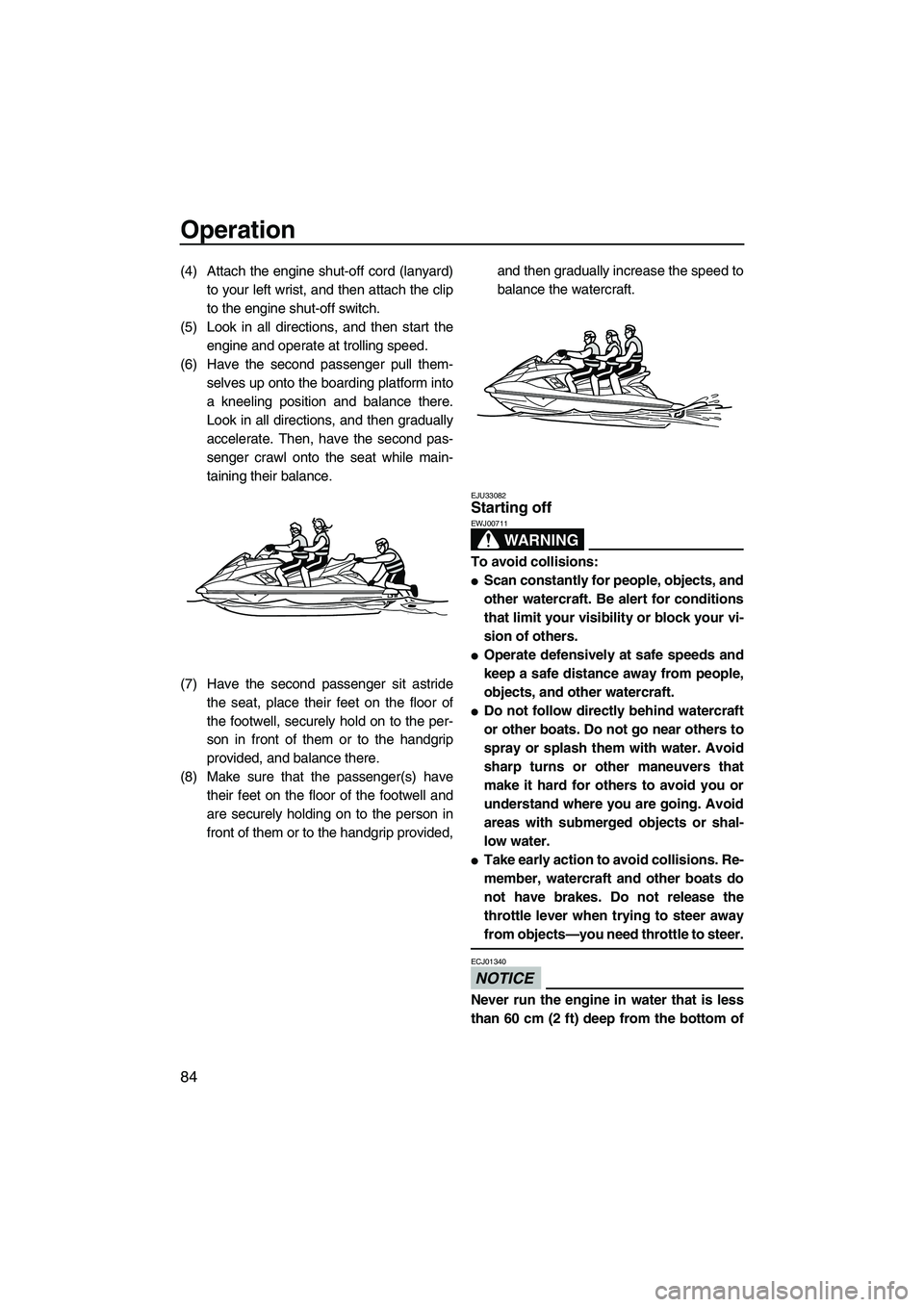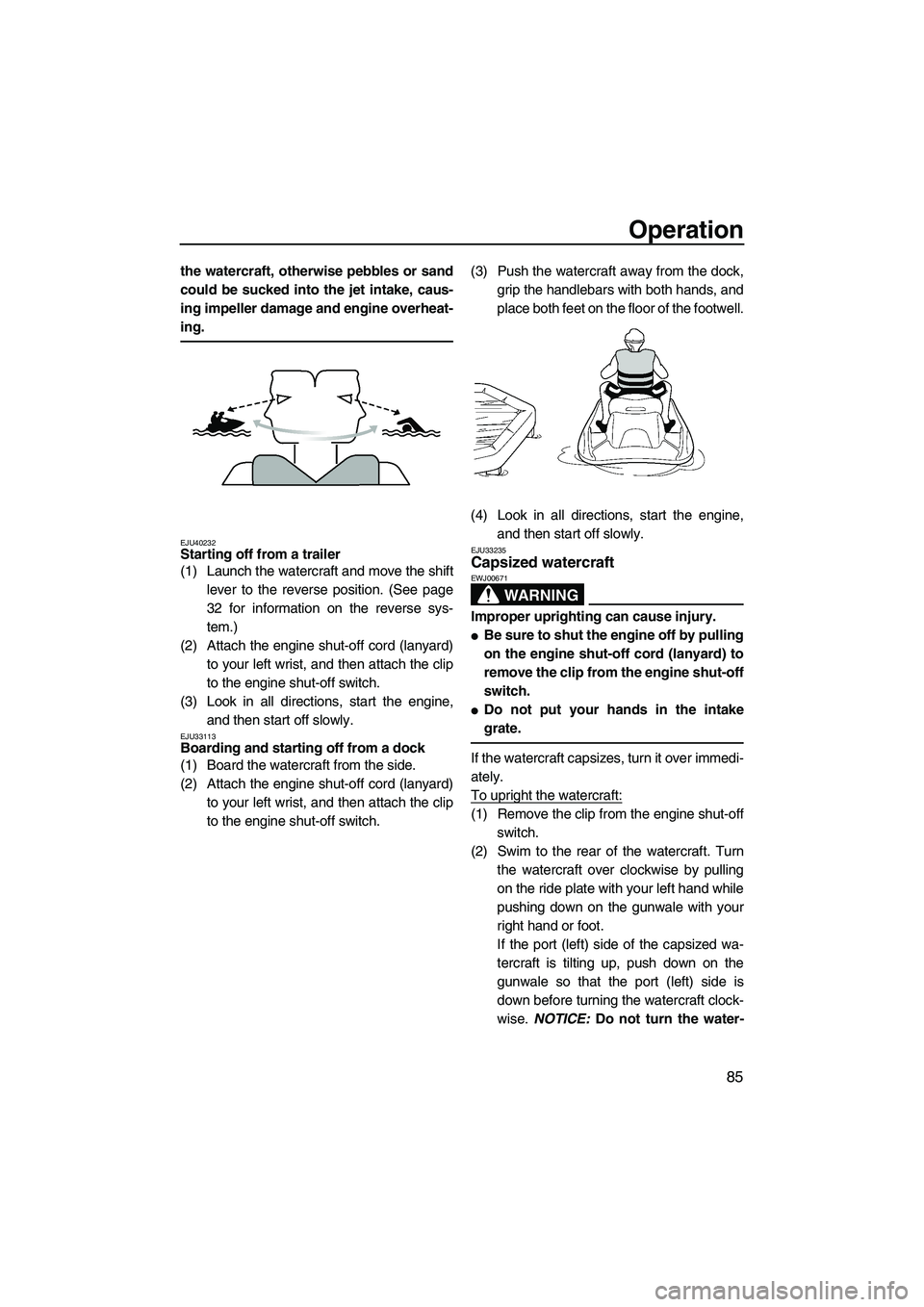2013 YAMAHA FX HO lock
[x] Cancel search: lockPage 86 of 116

Operation
80
objects, and other watercraft to give you
time to stop.
●Do not shut the engine off when slowing
down in case you need engine power to
steer away from a boat or other obstacle
that comes into your path.
●Do not use the reverse function to slow
down or stop the watercraft as it could
cause you to lose control, be ejected, or
impact the handlebars.
EJU42501Operating the watercraft in reverse or
neutral
Operating in reverse
Squeeze the shift lock lever and pull the shift
lever rearward until it stops in the reverse po-
sition. The watercraft will move in reverse.(See page 32 for information on operating the
shift lever.)
Make sure that there are no obstacles or peo-
ple behind you before shifting into reverse.
TIP:
This model is equipped with a function which
limits the engine speed in reverse.
Operating in neutral
Push the shift lever forward until it locks in the
neutral position. The neutral position balanc-
es forward and reverse thrust to help keep the
watercraft from moving, although some
1
Shift lock lever
2 Shift lever
3 Reverse position
2
31
UF2S71E0.book Page 80 Tuesday, August 21, 2012 2:33 PM
Page 90 of 116

Operation
84
(4) Attach the engine shut-off cord (lanyard)to your left wrist, and then attach the clip
to the engine shut-off switch.
(5) Look in all directions, and then start the engine and operate at trolling speed.
(6) Have the second passenger pull them- selves up onto the boarding platform into
a kneeling position and balance there.
Look in all directions, and then gradually
accelerate. Then, have the second pas-
senger crawl onto the seat while main-
taining their balance.
(7) Have the second passenger sit astride the seat, place their feet on the floor of
the footwell, securely hold on to the per-
son in front of them or to the handgrip
provided, and balance there.
(8) Make sure that the passenger(s) have their feet on the floor of the footwell and
are securely holding on to the person in
front of them or to the handgrip provided, and then gradually increase the speed to
balance the watercraft.
EJU33082Starting off
WARNING
EWJ00711
To avoid collisions:
●Scan constantly for people, objects, and
other watercraft. Be alert for conditions
that limit your visibility or block your vi-
sion of others.
●Operate defensively at safe speeds and
keep a safe distance away from people,
objects, and other watercraft.
●Do not follow directly behind watercraft
or other boats. Do not go near others to
spray or splash them with water. Avoid
sharp turns or other maneuvers that
make it hard for others to avoid you or
understand where you are going. Avoid
areas with submerged objects or shal-
low water.
●Take early action to avoid collisions. Re-
member, watercraft and other boats do
not have brakes. Do not release the
throttle lever when trying to steer away
from objects—you need throttle to steer.
NOTICE
ECJ01340
Never run the engine in water that is less
than 60 cm (2 ft) deep from the bottom of
UF2S71E0.book Page 84 Tuesday, August 21, 2012 2:33 PM
Page 91 of 116

Operation
85
the watercraft, otherwise pebbles or sand
could be sucked into the jet intake, caus-
ing impeller damage and engine overheat-
ing.
EJU40232Starting off from a trailer
(1) Launch the watercraft and move the shiftlever to the reverse position. (See page
32 for information on the reverse sys-
tem.)
(2) Attach the engine shut-off cord (lanyard) to your left wrist, and then attach the clip
to the engine shut-off switch.
(3) Look in all directions, start the engine, and then start off slowly.
EJU33113Boarding and starting off from a dock
(1) Board the watercraft from the side.
(2) Attach the engine shut-off cord (lanyard)to your left wrist, and then attach the clip
to the engine shut-off switch. (3) Push the watercraft away from the dock,
grip the handlebars with both hands, and
place both feet on the floor of the footwell.
(4) Look in all directions, start the engine, and then start off slowly.
EJU33235Capsized watercraft
WARNING
EWJ00671
Improper uprighting can cause injury.
●Be sure to shut the engine off by pulling
on the engine shut-off cord (lanyard) to
remove the clip from the engine shut-off
switch.
●Do not put your hands in the intake
grate.
If the watercraft capsizes, turn it over immedi-
ately.
To upright the watercraft:
(1) Remove the clip from the engine shut-offswitch.
(2) Swim to the rear of the watercraft. Turn the watercraft over clockwise by pulling
on the ride plate with your left hand while
pushing down on the gunwale with your
right hand or foot.
If the port (left) side of the capsized wa-
tercraft is tilting up, push down on the
gunwale so that the port (left) side is
down before turning the watercraft clock-
wise. NOTICE: Do not turn the water-
UF2S71E0.book Page 85 Tuesday, August 21, 2012 2:33 PM
Page 92 of 116
![YAMAHA FX HO 2013 Owners Manual Operation
86
craft over counterclockwise,
otherwise water can enter the engine,
which can result in severe damage.
[ECJ00541]
(3) Start the engine and operate the water-craft at planing speed to drain YAMAHA FX HO 2013 Owners Manual Operation
86
craft over counterclockwise,
otherwise water can enter the engine,
which can result in severe damage.
[ECJ00541]
(3) Start the engine and operate the water-craft at planing speed to drain](/manual-img/51/49770/w960_49770-91.png)
Operation
86
craft over counterclockwise,
otherwise water can enter the engine,
which can result in severe damage.
[ECJ00541]
(3) Start the engine and operate the water-craft at planing speed to drain the bilge
water from the engine compartment.
(See page 61 for information on draining
the bilge water. If the engine does not
start, see “Towing the watercraft” on
page 106 or “Submerged watercraft” on
page 107.) NOTICE: Do not run the en-
gine at full throttle for at least 1 minute
after the engine has been restarted.
Bilge water in the engine compart-
ment can splash into the engine,
which can result in severe damage.
[ECJ00553] EJU42590
Beaching and docking the watercraft
To beach the watercraft:
(1) Make sure that there are no boats, swim-
mers, or obstacles near the beach.
(2) Release the throttle lever to reduce speed about 110 m (360 ft) before you
reach the intended beaching area.
(3) Slowly approach the beach and stop the engine just before reaching land.
WARNING! You need throttle to steer. Shutting the engine off can cause you
to hit an obstacle you are attempting
to avoid. A collision could result in se-
vere injury or death.
[EWJ00601] NOTICE:
Never run the engine in water that is
less than 60 cm (2 ft) deep from the
bottom of the watercraft, otherwise
pebbles or sand could be sucked into
the jet intake, causing impeller dam-
age and engine overheating.
[ECJ00472]
(4) Get off the watercraft and pull it up on the beach.
To dock the watercraft:
(1) Make sure that there are no boats, swim- mers, or obstacles near the dock.
(2) Release the throttle lever to reduce speed about 110 m (360 ft) away from the
dock.
(3) Slowly approach the dock and stop the engine just before coming alongside it.
WARNING! You need throttle to steer. Shutting the engine off can cause you
to hit an obstacle you are attempting
to avoid. A collision could result in se-
vere injury or death.
[EWJ00601]
(4) Come alongside the dock and get off the watercraft.
EJU37193Operating in weeded areas
Always avoid using your watercraft in areas
where weed growth is thick. If operating in
UF2S71E0.book Page 86 Tuesday, August 21, 2012 2:33 PM
Page 104 of 116

Specifications
98
EJU34542
Specifications
Watercraft capacity:
Maximum people on board:3 person
Maximum load capacity: 240 kg (530 lb)
Dimensions:
Length:
3560 mm (140.2 in)
Width: 1230 mm (48.4 in)
Height: 1230 mm (48.4 in)
Dry weight: FX SHO 386 kg (851 lb)
FX Cruiser SHO 387 kg (853 lb)
Performance:
Maximum output (according to ISO 8665/SAE
J1228):154.5 kW@7500 r/min
Maximum fuel consumption:
63.7 L/h (16.8 US gal/h, 14.0 Imp.gal/h)
Cruising range at full throttle: 1.10 hour
Trolling speed: 1250 ±100 r/min
Engine:
Engine type:
Liquid cooled 4-stroke, DOHC
Number of cylinders: 4
Engine displacement:
1812 cm³
Bore & stroke: 86.0 × 78.0 mm (3.39 × 3.07 in)
Compression ratio: 8.6 : 1
Valve clearance-intake (cold):
0.14–0.23 mm (0.0055–0.0091 in)
Valve clearance-exhaust (cold): 0.28–0.37 mm (0.0110–0.0146 in)
Lubrication system: Wet sump
Cooling system:
Water
Starting system: Electric Ignition system:
T.C.I.
Spark plug: LFR6A
Spark plug gap:
0.8–0.9 mm (0.031–0.035 in)
Battery capacity: 12 V, 19 Ah
Charging system: Flywheel magneto
Drive unit:
Propulsion system:Jet pump
Jet pump type: Axial flow, single stage
Impeller rotation: Counterclockwise
Jet thrust nozzle angle:
24.0+24.0 °
Jet thrust nozzle trim angle: -10, -5, 0, 5, 10 °
Fuel and oil:
Recommended fuel:
Regular unleaded gasoline
Minimum octane rating (PON): 86
Minimum octane rating (RON): 90
Recommended engine oil type SAE:
SAE 10W-30, 10W-40, 20W-40, 20W-50
Recommended engine oil grade API: API SE,SF,SG,SH,SJ,SL
Fuel tank total capacity: 70 L (18.5 US gal, 15.4 Imp.gal)
Engine oil quantity with oil filter replacement:
3.1 L (3.28 US qt, 2.73 Imp.qt)
Engine oil quantity without oil filter replacement: 3.0 L (3.17 US qt, 2.64 Imp.qt)
Engine oil total quantity: 4.3 L (4.55 US qt, 3.78 Imp.qt)
UF2S71E0.book Page 98 Tuesday, August 21, 2012 2:33 PM
Page 105 of 116

Trouble recovery
99
EJU34561
Troubleshooting
If you have any trouble with your watercraft, use the troubleshooting chart to check for the pos-
sible cause.
If you cannot find the cause, consult a Yamaha dealer.
EJU42351Troubleshooting chart
Confirm the possible cause and remedy, and then refer to the applicable page.
TROUBLE POSSIBLE CAUSE REMEDYPAGE
Engine does not
start (Starter motor
does not turn over) Yamaha Se-
curity System
Lock mode selected Select unlock mode
27
Engine shut-
off switch Clip not in place Install clip
28
Fuse Burned out Replace fuse and
check wiring 103
Battery Run down Recharge89
Poor terminal con-
nections Tighten as required
89
Terminal corroded Clean or replace 89
Starter motor Faulty Have serviced by
Yamaha dealer —
Engine does not
start (Starter motor
turns over) Throttle lever Squeezed
Release28
Fuel Fuel tank empty Refill as soon as pos-
sible 58
Stale or contaminat-
ed Have serviced by
Yamaha dealer
—
Fuel tank Water or dirt present Have serviced by Yamaha dealer—
Spark plug Fouled or defective Have serviced by Yamaha dealer—
Spark plug
cap Not connected or
loose Have serviced by
Yamaha dealer
—
Connected to wrong
cylinder Have serviced by
Yamaha dealer
—
Fuel injec-
tion system Fuel pump faulty Have serviced by
Yamaha dealer —
Throttle lever Faulty Have serviced by
Yamaha dealer —
UF2S71E0.book Page 99 Tuesday, August 21, 2012 2:33 PM